Easy Sourdough Starter
This Easy Sourdough Starter recipe creates gorgeously fluffy homemade products such as Sourdough Baguettes. Included are simple step by step instructions on how to start, feed and Maintain Sourdough Starter that is perfect for beginners.
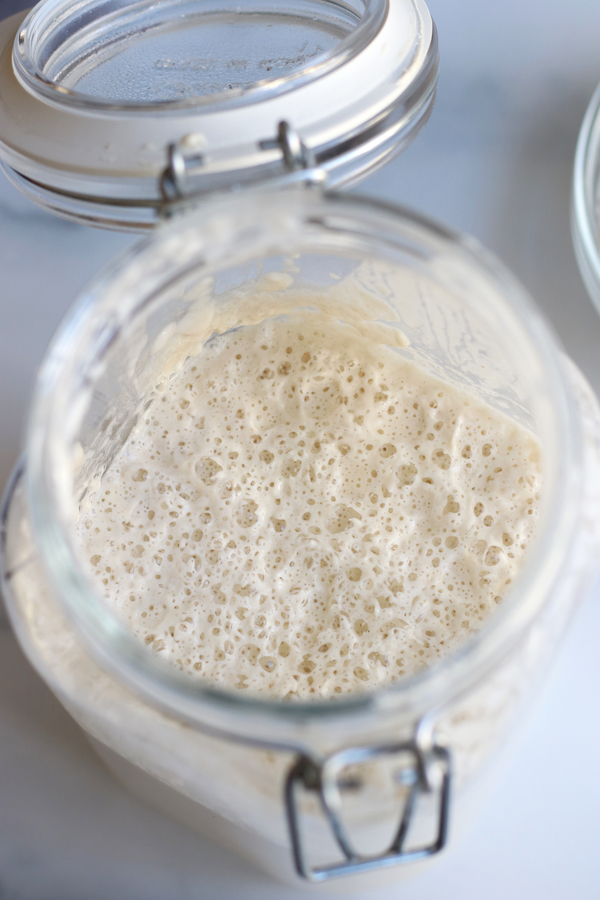
This post may contain affiliate links which I earn a small portion in sales if a purchase is made. Rest assured though, it is never at any additional cost to you.
What is Sourdough Starter
Very simply, sourdough starter is a fermented mixture of two ingredients, water and flour. Wild yeast found in flour flourishes when added to water and is allowed to rest in between feedings. This approach is the old fashioned way of making bread that has been done for centuries. It does require more time than active-dry or instant yeast but produces exceptional taste and textured baked goods.
Tools Needed
In addittion to the flour and water a few tools are needed to make your own from scratch Sourdough Starter.
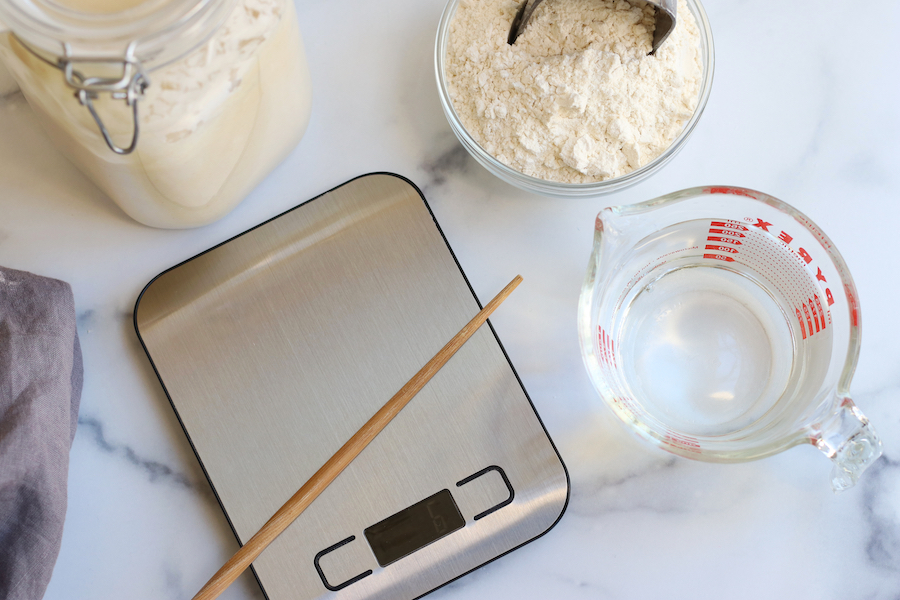
- Kitchen Scale- It is highly encouraged to use a kitchen scale to weigh the flour and water in equals parts to achieve the best results. This is the scale shown in the picture above. However, my next kitchen scale will be a little larger to accommodate the large bowl needed to make sourdough bread.
- Chopsticks– This makes stirring the starter in a glass jar much easier.
- Glass Measuring Cup– Makes for easy pouring of water.
- Scoop or Spoon– Helps with the addittion of flour.
- Medium Sized Glass Bowl– The first few days of a starters life is easier done in a medium size glass bowl.
- Plastic Wrap or Reusable Food Wraps– For the first few days of the starters life.
- Glass Jar (see below)
Sourdough Starter Container
The type of glass jar needed will depend on which type of flour you use to make your starter and how rapidly your starter ferments. This is the jar seen in the photo below and it works beautifully when using white all-purpose flour. Please see section directly below (White Flour vs Wheat Flour) for more explanation.
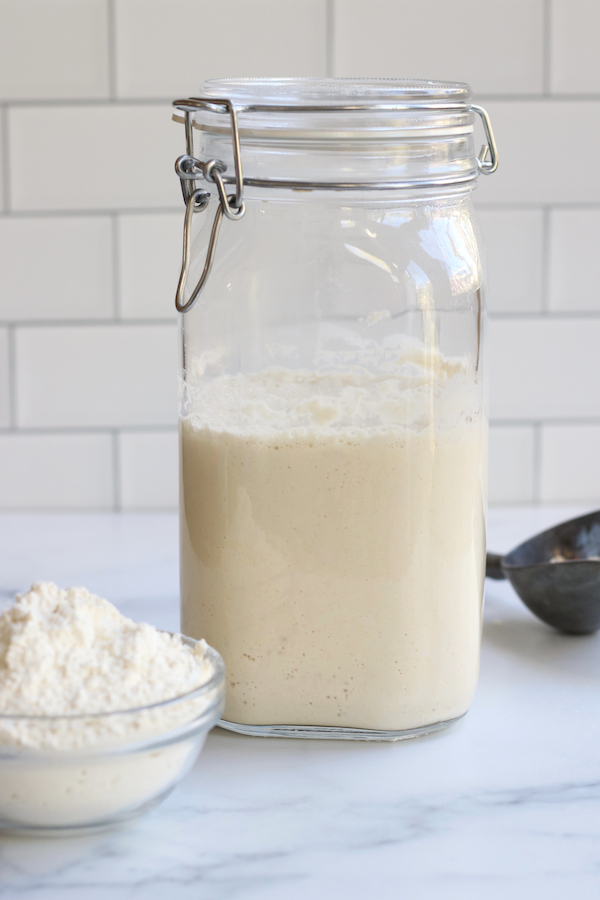
Best Flour for Sourdough Success
For the best sourdough starter, you need flour you can trust. Buying directly from King Arthur Flour means guaranteed freshness, expert-tested quality, and no risk of warehouse mishandling. Plus, you’ll find exclusive products, better stock availability, and support an employee-owned company dedicated to bakers. Skip the third-party markups and get the best right from the source. You and your sourdough deserve it! (affiliate)
White Flour vs Wheat Flour
The type of flour used will have a great influence on how your Stater ferments and the final product that you make with it. However, it is most important to not choose bleached flour as this will impede the fermentation.
All-Purpose White Flour
I adore sourdough bread that bites me back when I eat it. In other words, extra sour with a tang. However, my husband HATES that kind of bread. That is why I use all-purpose white flour for my Starter.
This type of flour yields breads that are very much like a crusty Italian loaf that he and I both go crazy for. Additionally, I use the Starter from this type of flour for making baguettes that then make incredible Homemade Breadcrumbs and croutons. The final products are never overly sour.
Wheat or Rye Flour
Wheat and rye flour has more naturally occurring wild yeast. Because of this, the starter made from these types of flours will ferment faster and with more intensity. It is very important to keep a closer eye on Starters made from these flours and to use a glass jar that has a lid that is looser or can be left slightly open. The reason for this, a tight fitting lid could be a recipe for an exploding jar.
In conclusion, wheat and rye flours will make much stronger sourdough products and all-purpose white flours (unbleached) will yield more mild final products.
How To Make
To make Sourdough Starter that is ready to bake with will take approximately 7 days, give or take a day or two. Here are the instructions for each day.
Day 1
In a medium sized glass bowl mix together 50 grams of water and 50 grams of flour. Stir well and cover. Let sit at room temperature.
Pro Tip#1– To accurately weigh the flour and water start by making sure the scale is weighing in grams vs ounces. Place the bowl on the scale and turn on. The scale should read zero with the the bowl on top. Add enough flour to equal 50 grams. Calibrate the scale back to zero again and repeat with water.
Pro Tip#2– In the making and feeding of this starter there will always be equal parts of flour and water added to it.
Day 2
To yesterday’s mixture add 50 grams of flour and 50 grams of water. Stir well and cover. Let sit at room temperature.
Day 3
Throw away half of the Starter. To the remaining Starter add 100 grams of flour and 100 grams of water. Stir well and cover. Let sit at room temperature.
Pro Tip#3– The discarded Starter from day 3- day 6 is not fully developed enough to have any uses. Simply throw it away.
Day 4
Throw away half of the starter. Add 150 grams of flour and 150 grams of water to the bowl and stir well. Cover and let sit at room temperature.
Pro Tip#4– Day 4 is the day that you will notice the mixture starting to take on the personality of a Sourdough Starter. There should be small bubbles and a slight sour smell will start to take shape.
Day 5
Similar to the previous days, throw away half of the Starter and add 150 grams of flour and 150 grams of water. Stir well, cover and let sit at room temperature.
Pro Tip#5– The Starter should begin to look very similar to picture A below. If not do not worry, it will very soon. Also, feel free to transfer to the glass jar once the new flour and water its mixed in on day 5.
Day 6
Throw away half of the starter and add 200 grams of flour and 200 grams of water. Stir well, cover and let sit at room temperature.
Pro Tip#6– By day 6 the Starter should look similar to photo A below and very possibly look like photo B.
Day 7
On day 7 the Starter should at the least look like photo B if not like photo C. If it has a similar appearance to photo C, it is ready to use. If it looks like photo B, let it sit at room temperature for one additional day.
Feeding and Reviving Sourdough Starter
Above all, if your Starter looks like photo C it is ready to be used for making all kinds of sourdough products. If it looks like photo B, you can still use it for baking. However, it will slow down the rising of bread dough. When it looks like photo A, it is time to feed the Starter.
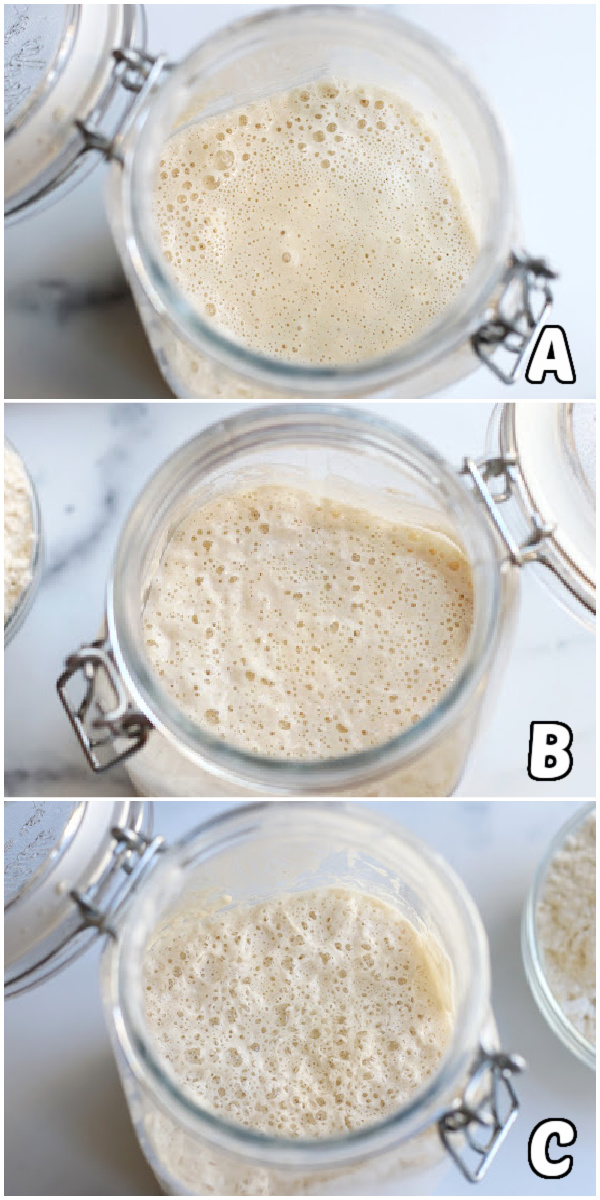
To feed the Sourdough Starter, discard half of it and add 150 grams of flour and 150 grams of water to the remaining Starter. Stir well and let sit at room temperature overnight. If on the second day the Starter has the appearance of photo B, let it sit at room temperature for one additional day before using it in recipes.
Pro Tip#7– If storing the Starter at room temperature it will need to be fed every 2-3 days. If storing in the refrigerator, it can be kept safely for up to 10 days before feeding. Please note that if storing in the refrigerator 2 feedings will most likely be needed before the Starter will look like photo C.
Starter Smell and How to Know if it has Gone Bad
A healthy Sourdough Starter is going to smell sour. Therefore, it is not the best way to judge whether it has gone bad. However, the best way to know is by its appearance. If there are any visible signs of mold or red/orange spots it is time to throw the Starter out and begin again. Take heart though, Sourdough Starters are full of good bacteria. Because of this, chances of it going bad are much lower.
Maintaining Sourdough Starter
For anyone new to sourdough baking, it is incredibly normal to have many questions and concerns about maintaining your sourdough starter. How To Maintain Sourdough Starter has a complete breakdown of the feeding schedule, common concerns and questions so that you can enjoy your sourdough starter for decades to come.
If you enjoyed this Sourdough Starter please let me know by leaving a comment and review below. Doing so helps to encourage others to make the recipe also. Thank you!
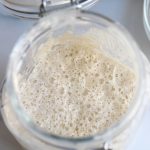
Easy Sourdough Starter
Ingredients
- 700 grams white all-purpose flour *see Note #1 below
- 700 grams filtered water
Instructions
Day 1
- In a medium sized glass bowl mix together 50 grams of water and 50 grams of flour. Stir well and cover. Let sit at room temperature.See Note #2 and Note #3 below.
Day 2
- To yesterday’s mixture add 50 grams of flour and 50 grams of water. Stir well and cover. Let sit at room temperature.
Day 3
- Throw away half of the Starter. To the remaining Starter add 100 grams of flour and 100 grams of water. Stir well and cover. Let sit at room temperature.See Note #3 below.
Day 4
- Throw away half of the starter. Add 150 grams of flour and 150 grams of water to the bowl and stir well. Cover and let sit at room temperature. See Note #4 below.
Day 5
- Similar to the previous days, throw away half of the Starter and add 150 grams of flour and 150 grams of water. Stir well, cover and let sit at room temperature. See Note #5 below.
Day 6
- Throw away half of the starter and add 200 grams of flour and 200 grams of water. Stir well, cover and let sit at room temperature. See Note #6 below.
Day 7
- On day 7 the Starter should at the least look like photo B above if not like photo C. If it has a similar appearance to photo C, it is ready to use. If it looks like photo B, let it sit at room temperature for one additional day.

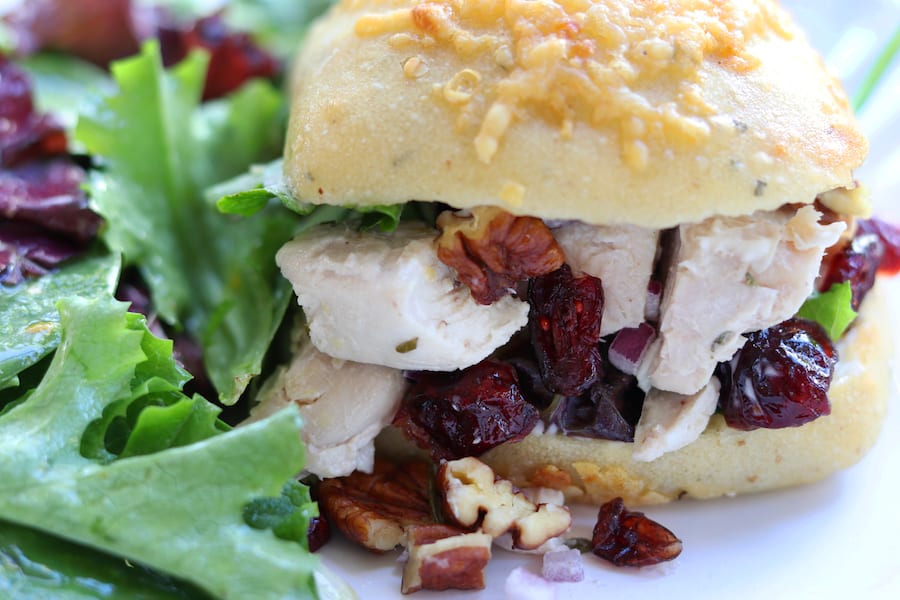
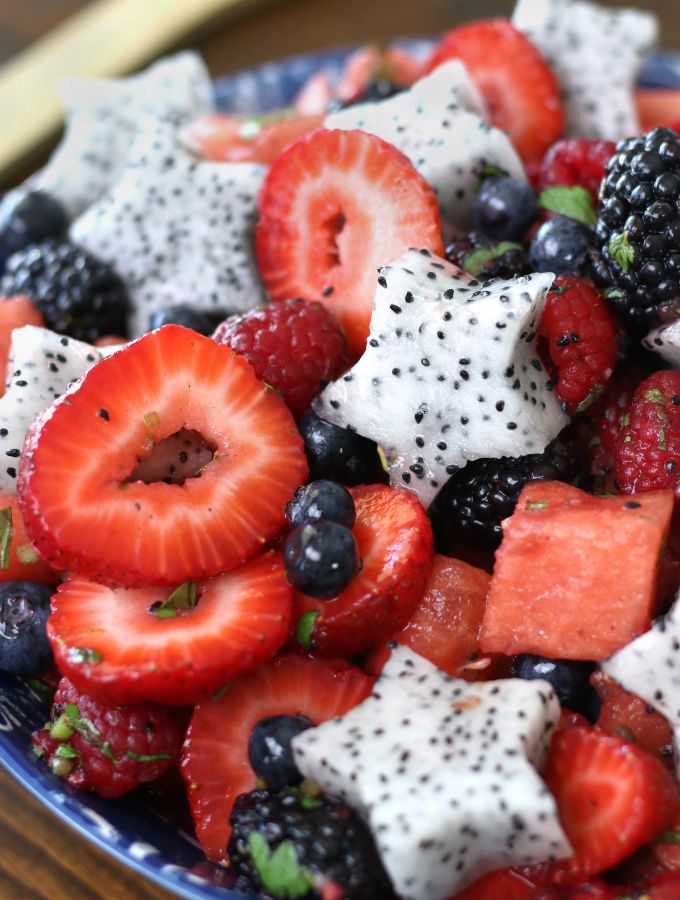
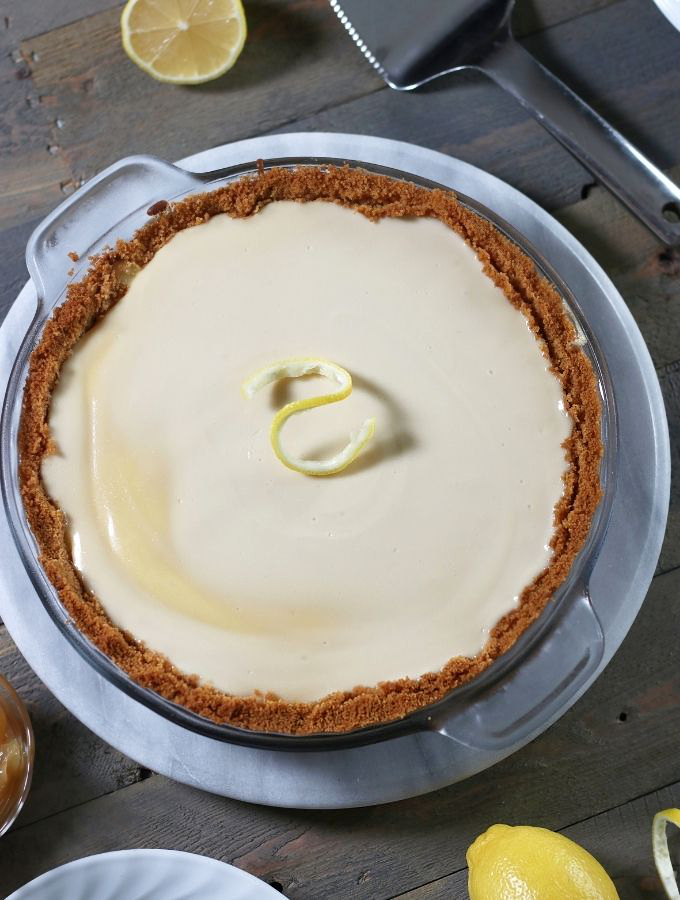
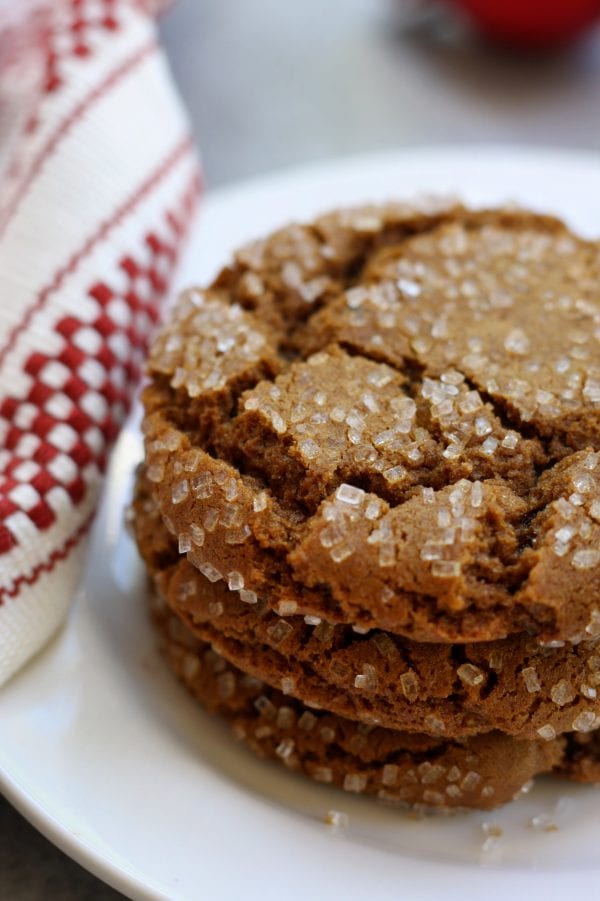
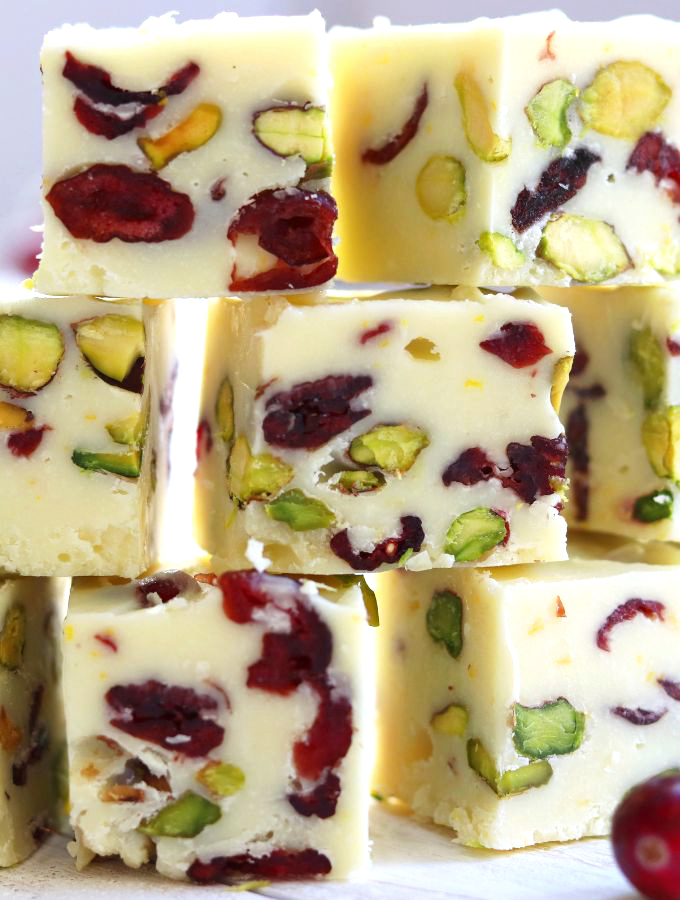
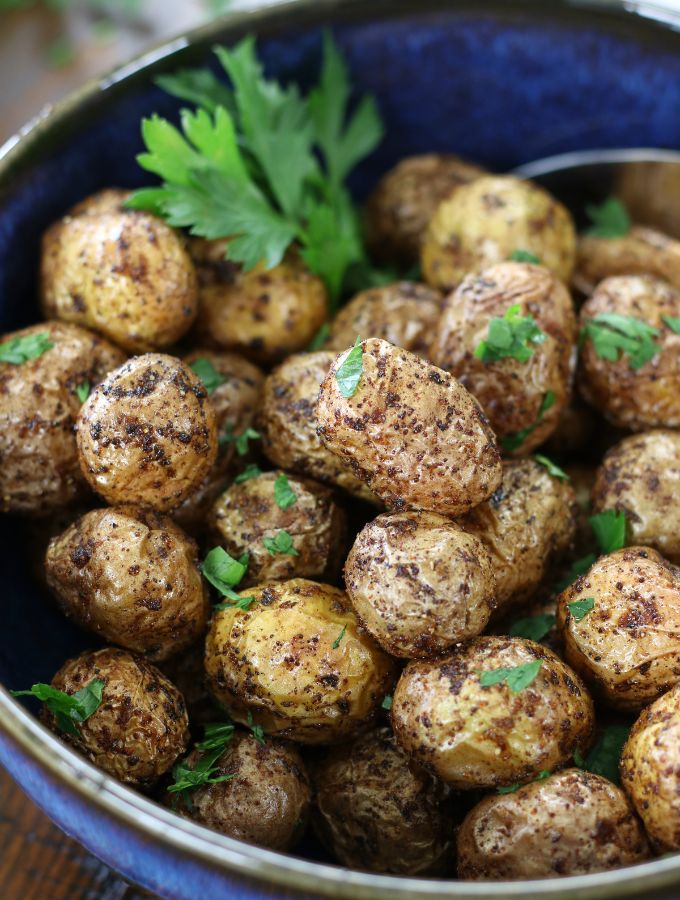
I very much appreciate this tutorial. As a beginner it’s been really helpful to have this break down along with photos so I know what I’m looking for in my starter
That makes me so happy to hear. I am working on a post about how to maintain your sourdough starter. So stay tuned because I should have it done in the new year.
I agree. The photos and each day tips are extremely helpful as a beginner. This is the 3rd time I’m trying a new recipe for my first starter and the first time everything is going according to directions. Thank you for helping us visual learners out.
That makes me so happy to hear!!
Hi, I made an active starter, even cooked several batches of bread but have been keeping my start in the fridge. It gets clear liquid almost every other day now and my bread isn’t rising much at all. What have I done wrong?
Hi Georgie. This is a really good question and I am so glad you are asking.
The clear liquid you are seeing is called hootch and it a very normal part of the starter as it looses its umpff. It is super important to not drain the hootch (the name kills me), but rather stir it in. Seeing the hootch also means that you probably have 3-5 days of feeding necessary before the starter is ready to make bread again.
Also, keeping it in the refrigerator is completely fine but you may notice better results keeping it at room temperature. I keep ours on our kitchen countertop and we keep our house at about 70℉.
I am currently working on a post about maintaining your sourdough starter and it has been weeks since I have fed it. The reason I am waiting so long is I want to show photos of how the hootch darkens as it sits. As long as no mold forms, the hootch is part of what gives sourdough bread its wonderful tangy flavor.
I hope this helps. Stayed tuned into the new year when I should have the maintaining sourdough starter post done.
I’ve been working on my starter for a week and a half. It doesn’t really double in size. It just kind of bubbles a bit and then gets the hooch on top. I discard and feed it every day 150 g of water and flour.
Hi Laura. I’ve have seen conflicting information about this. It’s been my experience that stirring the hooch back into the starter before discarding half is
super important for the quality of the starter. Whenever hooch is present, it means that your starter is hungry. Also, the hooch is what gives the starter that wonderful sourdough tang. So long story short, I would suggest to keep going. You’re probably not far from it being ready to make bread.
Good morning! I’m new here and know nothing about making. sourdough bread I’m on day 3! My question is, do you have information on how I bake it, like the temperature and what kind of pan that is needed?
Hi Angela. Welcome, so happy to have you here. So far I have Sourdough Baguettes published. https://www.thefedupfoodie.com/sourdough-baguettes/ Sourdough French Bread is very similar is a very similar approach as far as oven temperature. I recommend using the pans I have linked in the baguette post. Bake time is usually about 40-45 minutes. I am currently working on the Sourdough French Bread post and how to maintain the sourdough starter, so stay tuned for those.
So I messed up and added 100g of each water and flour on the 2nd day. Will it still be okay or did I completely ruin it?
You are ok. It may slow the process down by a day or two but just keep going.
so I did the starter according to your directions. However, I stored it in the refrigerator. Do I keep going with the rest of the days and keep it in the fridge or should I move it to the counter? I’m so excited to try this bread. it look so good!
Hi Lori. I am excited for you to try it also. I would keep the starter on the counter, feeding it as necessary until it is ready to make bread. I am currently working on a recipe post about maintaining sourdough starter, so stay tuned. Also, I keep my starter on the counter all the time and we keep our house at about 65-72 degrees.
when using the starter after taking for bread making what should I be doing to help keep my starter?
That is a great question. Long story short, just make sure to place a lid on it and store either on the kitchen counter or refrigerator. When ready to make bread again, start the feeding and discarding process until it is bubbly and healthy. I am currently working on a recipe post about maintaining the sourdough starter. It will answer all the common questions that pop up for most people. Look for the post sometime in mid January.
I see that you used a bowl and covered with plastic wrap. Can the starter also be made in the jar and closed with the jar lid like the jar linked in your recipe?
Hi Robin, that is such a good question. It really is easiest to start in a bowl since it is a small amount of water and flour. As you progress, the jar becomes highly useful.
Thank you so much for the starter! One question, I’m on day 6 and I have the “sour smell” but I’m seeing a lot of hooch and have a watery starter with it much activity. I changed my water to spring since I’m in a well and have fed it sooner than 24 hours since I’m seeing hooch (I just am mixing it back in). Any other advice?
Thanks a ton!
You are doing the best thing. The hooch is super important for the sourdough flavor. Since all starters have a bit of a different personality you may need to keep feeding another 3 or so days. Also, a trick I do when my starter is too watery is to use 150 grams of flour but only 100-125 grams of water (depending on how watery it is). A few days of this usually does the trick.
Please keep me updated. I would love to hear how it turns out.
happy holidays
i just started the starter using your measurements and am excited to do this process again after many years.
what always seem to me was such a waste (yes I’m a miser) if throwing the portion away after the starter process has completed is their no other usage for this?
Hi Sandra. I completely understand how you feel. So there are options with the discard such as making crackers, pancakes, quick breads, etc. I apologize that I don’t have any of those recipes at the moment. I am hoping to have more throughout 2024.
Hello,
What’s the best way to store this if you leave in vacation? Thank you!
Hi Dawn. You can either leave it on your kitchen countertop if your house stays fairly cool or refrigerate it and then start the process of feeding when you return. Also, it is best to put a lid on it when storing as compared to a paper towel when feeding.
I hope you have a wonderful vacation.
Where do I get the recipe to start and make a loaf of sour dough bread?
Hi Sue. At the moment I have the Sourdough Baguette recipe available. https://www.thefedupfoodie.com/sourdough-baguettes/
I am currently working on Sourdough French Bread and will have the other loaf recipes completed hopefully by Spring. Stay tuned and I apologize that I don’t have more available just yet.
Really excited to give this a try! But can you use unbleached bread flour for this recipe? I use it to make all of my other breads…French bread, Italian bread, artisan bread etc and I love the difference it makes compared to using all purpose flour
Thanks!!
Hi Lynne. I apologize for the delay as we are just getting back from vacation.
Yes, you absolutely can use bread flour for sourdough starter. Each type of flour will yield a bit different results. However, using bread flour in your sourdough starter will create a robust and elastic consistency that many people adore.
After day 7, when you need to feed the starter how often and how much should you be feeding it?
Hi Jocelyn. I will be publishing a post that answers all the common questions about maintaining Sourdough Starter within this week. In the meantime, feeding it all depends on how often you plan on making bread. While your starter is under 6 months it is a good idea to feed consistently (once a day or every other day). Once it has matured past 6 months, it just depends on your sourdough needs.
I have been wanting to start a sourdough starter for a while now but didn’t really know where to start. This guide has been super helpful! I am now on day 7 with my starter.
My question is, what should I do if my starter instead getting as bubbly as pictures B and C? It grows with feedings but typically only has small bubbles. Does household temperature effect that? My household is typically between 74-78⁰. Do I need to be feeding my starter more frequently?
That is such a great question. Each sourdough starter is going to have a bit of a different personality, especially depending on the type of flour used. Your house temperature is perfect, so no worries there. If in doubt as to whether the starter is ready to make bread, it always a good idea to keep feeding it for a few more days. Watch to see if the bubbles change appearance within that time frame. By doing this, you will get a good idea of how your starter will look when it is ready to make bread.
I’m super new to sourdough… I’ve been trying to start it and it’s not worked yet for me. So in your recipe are you adding an additional 100 gram of water and 100 grams of flour. So i would take scale back to ZERO and add 100 gram of flour back to zero and add 100 grams of water?
And once your dough is ready… are you using the whole thing then for the bread? Or half of it and keeping the mixture going?
Thank you for your patience!!!
Hi Tina. I love your questions and completely understand how it feels when you first start. Taking the scale back to zero is called “taring” the scale and is always a good idea with each food item that is weighed. Once the sourdough starter is ready to make bread, you will only be using a portion of the starter to make bread. It all depends on the bread recipe you are making. I highly recommend starting with a French Baguette recipe (see link below) when you are fist starting or French Bread recipe (coming soon). Also, I will be publishing a commonly asked questions and common challenges people have when making sourdough starter within the week.
I hope this helps and please feel free to ask as many questions as you need.
Is the baguette recipe the same as a loaf of bread after your starter is established?
It is very similar with the exception of the type of pan used and baking time.
Hi! This sourdough starter recipe is so easy to follow, thank you! After my starter is ready to bake, is it possible to save some for a 2nd batch?
That is wonderful to hear Betsy. To answer your question, you will only be using a part of the sourdough starter to make bread. The other part you will use to feed and make more bread. Basically, this sourdough original sourdough starter you are making can last for decades. I will be publishing a commonly asked question and challenges about sourdough starter within the week. Hopefully this will be a help also.
I’m on day 5 & so far so good. Should you stir the starter at any time between feedings? Most to all bubble & frothing activity is in the top half of my day 5 starter, not really on the bottom half of the jar. Should I stir it or leave it alone? Advice please?
Hi Lolo. I apologize for the delay. We are just getting back from vacation. I highly recommend to let the starter just sit in-between feedings. Stir just before feeding and just before making bread. I hope this helps.
Hi! I started this starter last week and all 7 days have passed. But my sourdough is runny, not bubbling, and doesn’t pass the float test. Is it ruined or is there any way to fix it?
Hi Lauren. So much of the health of the starter will depend on the type of flour and water used. I highly recommend to use filtered water and unbleached flour. If both of those were used, you may find better results switching up the flour. Many people love the results of bread flour because it creates a wonderful textured bread. Lastly, if both filtered water and unbleached flour were used, I would give its a few more days. Each sourdough starter is going to have a bit of a different personality. Some will just take a little longer than others to develop.